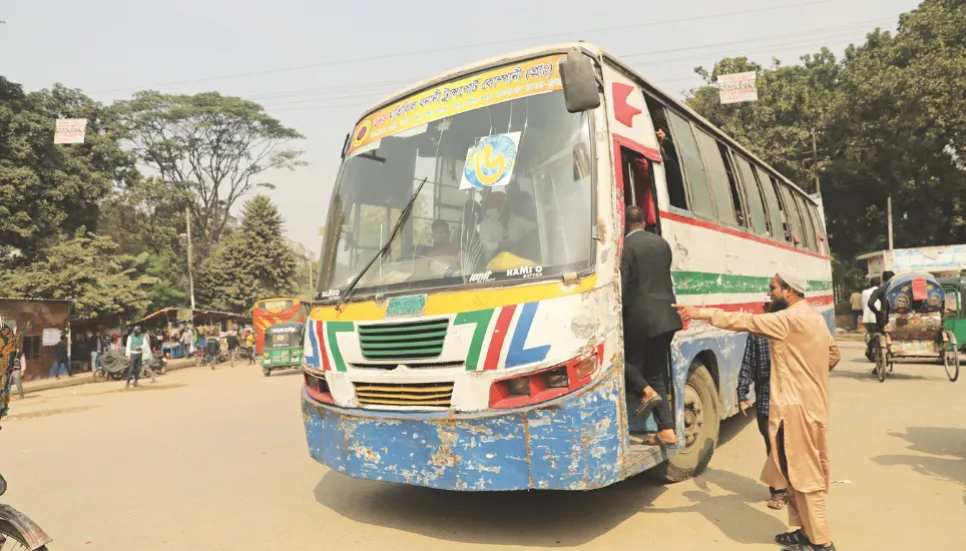
Whether it's the crack of dawn or the dead of night, the No 6 Motijheel-Banani bus in Dhaka city remains perpetually packed. From suited aristocrats to day labourers in lungis, this bus caters to everyone, symbolising the essence of affordability as well as extensive city travel.
Commuters cling to its trails during office hours. As a result of not finding a place inside, they are forced to hang outside. Many even prefer standing near the door of the bus than going inside.
Despite its slow speed, bus No 6, notorious for being the cheapest and most crowded, holds a special place in the hearts of Dhaka residents.
The fare of the bus, operated by Motijheel-Banani Transport Company Private Limited, starts from Tk 10 to Tk 40 (half for students), and it offers a journey across almost the entire city. The bus is often compared to a tortoise for its slow speed. This bus starts moving only when no room is left to pick up new passengers.
Despite its slow pace, the No 6 bus is beloved by many, offering a unique experience filled with drama, verbal spats and occasional physical altercations between passengers and staff. And almost every day this same scenario can be seen. As a result, those who are regular passengers of this bus have become accustomed to this environment.
The route of the No 6 bus is Motijheel to Banani via Gulistan-Paltan-Malibagh-Moghbazar-Karwan Bazar-Farmgate-Bijay Sarani-Mohakhali-Gulshan 1-Gulshan 2-Notun Bazar.
No one would believe how modern this bus was back in the 1960s. But now No 6 bus can be seen under the banner of various services. Sometimes one or two buses can be seen on the Badda Link Road-Gulshan-Mohakhali-Tejgaon route but their number is very limited.
Cheap and nostalgic
Starting its journey in 1958, the bus offers its cheap and comfortable journey till today. Even in 2013, the bus fare was Tk 3 to Tk 15. There are hardly any people in Dhaka city who have not ridden the No 6 Motijheel-Banani bus. It can be said that many started to know Dhaka city by riding this bus.
Md Harun Ar Rashid, assistant professor and head of the physics department at Birshrestha Munshi Abdur Rouf Public College, said, “I rode this bus a lot when I was a student at Notre Dame College from 1987 to 1989.”
“I started my journey from Gulistan to Stadium, Dainik Bangla, Motijheel, Arambagh and I got off at the Notre Dame College gate. The fare was 50 paisa back then, but I used to pay half means 25 paisa by showing my student ID card,” he added.
Rishad Khan, who now works at a private company, recalled, "I used to go to college from Gulshan 2 on this bus spending only Tk 2 as fare. I used to know only this bus to go from Motijheel to Gulshan or Banani. The bus would come to Farmgate and sit for two to three hours. I used to sit on the bus for too long.”
“I did not think that if I changed the bus and took another one, I could go to my destination earlier. One day the contractor paid me back the rest of the fare and told me to take another bus to get to my destination early as the No 6 bus I was on would be delayed. Since then, I do that,” he added.
A dying business?
Jamal Hossain, who owns some of the No 6 buses, said, “Our business is dying. Many of the owners have sold their buses and left the business. Our bad days started from the time of the Covid-19 pandemic. There were 40 buses even before the pandemic. But now there are only eight buses, and each of them can manage three trips every day.”
Recalling the past, he said, “Earlier, our buses were the only ones that operated on this route. Now many companies are operating on this route, providing more options to commuters.”
“However, we do have plans to expand our business but we can't get road permits for new vehicles. The authorities are not giving permits not only for this route but all the others as well, which leaves us with no way to improve the situation,” Jamal added.
Many transport workers are changing their workplace as well.
Al-Amin, a former driver of the No 6 bus, said, "In 1996, I started working on a No 6 bus as a helper. I became a driver in 2009. It was a big deal for me. The bus is huge. It has 52 seats and is very spacious compared to the other buses.”
“No 6 bus had a different horn. Other vehicles would move and give the bus space when they heard that horn,” he reminisced.
“Earlier, the bus used to run on time. There was a fixed waiting time for each stop. If a No 6 bus was late, there was a penalty of Tk 10 per minute. Until 2015, the buses used to operate like this. But now there is no order. That’s why I left,” he lamented.
A recent ride on this iconic bus revealed a spectrum of emotions, from the joy of a father showing his kids around Dhaka to the frustration of commuters stuck in the capital’s perpetual traffic jams.
The No 6 bus, with its diverse passengers and unpredictable journey, encapsulates moments of happiness and desolation.